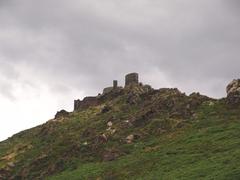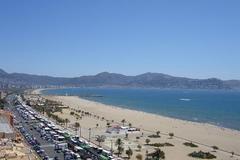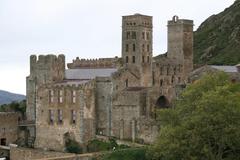Comprehensive Guide to Visiting Carretera Fonda, Roses, Spain
Date: 18/07/2024
Introduction
Carretera Fonda, located in the picturesque town of Roses on the Costa Brava, Spain, is not merely a road but a journey through the annals of history. This historic pathway offers an unparalleled glimpse into the rich cultural tapestry and historical evolution of Roses, making it an indispensable destination for history enthusiasts and travelers alike. From its ancient Greek and Roman roots to its medieval fortifications and modern developments, Carretera Fonda encapsulates the essence of Roses’ multifaceted heritage (Roses History).
Table of Contents
- Introduction
- Early Settlement and Ancient History
- Medieval Period
- The Modern Era
- Cultural Significance
- Architectural Heritage
- Historical Events
- Preservation Efforts
- Visiting Carretera Fonda
- Nearby Attractions
- Frequently Asked Questions (FAQ)
- Conclusion
Discovering Carretera Fonda - A Historical Journey through Roses, Spain
Early Settlement and Ancient History
The area now known as Carretera Fonda has a rich history that dates back to ancient times. The earliest known settlers were the Greeks, who established the colony of Rhode around the 8th century BC. This settlement was strategically located due to its proximity to the Mediterranean Sea, which facilitated trade and cultural exchange. The Greeks were followed by the Romans, who left a significant mark on the region. The remnants of Roman influence can still be seen in the ruins of the ancient city of Rhodes, which include a well-preserved Roman villa and a necropolis (Citadel of Roses).
Medieval Period
During the medieval period, Roses became an important defensive site. The construction of the Citadel of Roses, also known as the Ciutadella de Roses, began in the 16th century under the orders of King Charles V. This fortress was built to protect the town from pirate attacks and invasions by the French. The Citadel is a remarkable example of Renaissance military architecture and includes structures from different periods, such as the remains of a Greek settlement, a Roman villa, and a medieval monastery (Citadel of Roses).
The Modern Era
In the 19th and 20th centuries, Roses underwent significant changes. The town expanded beyond its medieval walls, and new neighborhoods were developed. The construction of Carretera Fonda, a major road that connects Roses with other parts of the Costa Brava, played a crucial role in this expansion. This road facilitated the movement of goods and people, contributing to the economic growth of the region. The development of tourism in the mid-20th century further transformed Roses, making it a popular destination for visitors from around the world (Costa Brava Tourism).
Cultural Significance
Carretera Fonda is not just a road; it is a symbol of the historical and cultural evolution of Roses. The road passes through areas that are rich in history, offering glimpses into the town’s past. For instance, along Carretera Fonda, visitors can find the Dolmen de la Creu d’en Cobertella, one of the largest megalithic monuments in Catalonia. This dolmen dates back to the 3rd millennium BC and is a testament to the prehistoric human activity in the region (Dolmen de la Creu d’en Cobertella).
Architectural Heritage
The architectural heritage along Carretera Fonda is diverse, reflecting the various periods of Roses’ history. The road is lined with buildings that showcase different architectural styles, from traditional Catalan houses to modernist structures. One notable example is the Church of Santa Maria, a Gothic-style church that was built in the 18th century. The church is known for its beautiful façade and intricate interior decorations (Church of Santa Maria).
Historical Events
Several historical events have taken place along Carretera Fonda, adding to its significance. During the Spanish Civil War (1936-1939), Roses was a site of strategic importance. The town and its surroundings, including Carretera Fonda, witnessed several battles and skirmishes. The remnants of bunkers and fortifications from this period can still be seen today, serving as a reminder of the town’s turbulent past (Spanish Civil War in Roses).
Preservation Efforts
Efforts to preserve the historical and cultural heritage of Carretera Fonda have been ongoing. The local government, along with various cultural organizations, has undertaken several initiatives to protect and promote the historical sites along the road. These efforts include the restoration of ancient monuments, the establishment of museums, and the organization of cultural events and festivals. One such initiative is the annual Roses History Festival, which celebrates the town’s rich heritage through reenactments, exhibitions, and guided tours (Roses History Festival).
Visiting Carretera Fonda
Visiting Hours and Tickets
Carretera Fonda is accessible year-round, and there is no admission fee to explore the road itself. However, some historical sites along the route, such as the Citadel of Roses and Dolmen de la Creu d’en Cobertella, may have specific visiting hours and ticket requirements. It is advisable to check the official websites or local tourism offices for the most up-to-date information.
Travel Tips
- Best Time to Visit: Spring and autumn are ideal for visiting, offering pleasant weather and fewer crowds.
- Accessibility: Most sites along Carretera Fonda are accessible, but some ancient ruins may have uneven terrain.
- Guided Tours: Consider joining a guided tour to gain deeper insights into the historical significance of the sites.
- Photography Spots: Don’t miss the panoramic views from the Citadel of Roses and the picturesque Dolmen de la Creu d’en Cobertella.
Nearby Attractions
- Aqua Brava Water Park: Perfect for family fun, located just a short drive from Carretera Fonda.
- Cap de Creus Natural Park: A stunning natural reserve ideal for hiking and nature enthusiasts.
- Roses Beach: Relax on the beautiful sandy beaches and enjoy water sports.
Frequently Asked Questions (FAQ)
Q: Are there guided tours available for Carretera Fonda?
A: Yes, guided tours are available and highly recommended to fully appreciate the historical context of the sites along the road.
Q: What are the visiting hours for the Citadel of Roses?
A: The Citadel of Roses typically opens from 10 AM to 8 PM during the summer months and has reduced hours in the winter. Please check the official website for the latest schedule.
Q: Is Carretera Fonda accessible for people with disabilities?
A: While most of Carretera Fonda is accessible, some ancient sites may have uneven terrain. It is advisable to check specific site accessibility in advance.
Conclusion and Call to Action
Carretera Fonda in Roses, Spain, is a journey through time. From its ancient Greek and Roman roots to its medieval fortifications and modern developments, the road encapsulates the rich and diverse history of Roses. Plan your visit today to experience the historical and cultural heritage of the Costa Brava. For more information, download our mobile app Audiala or follow us on social media for the latest updates and travel tips.
References
- Roses History. (n.d.). Retrieved from Roses History
- Citadel of Roses. (n.d.). Retrieved from Citadel of Roses
- Costa Brava Tourism. (n.d.). Retrieved from Costa Brava Tourism
- Dolmen de la Creu d’en Cobertella. (n.d.). Retrieved from Dolmen de la Creu d’en Cobertella
- Roses History Festival. (n.d.). Retrieved from Roses History Festival



